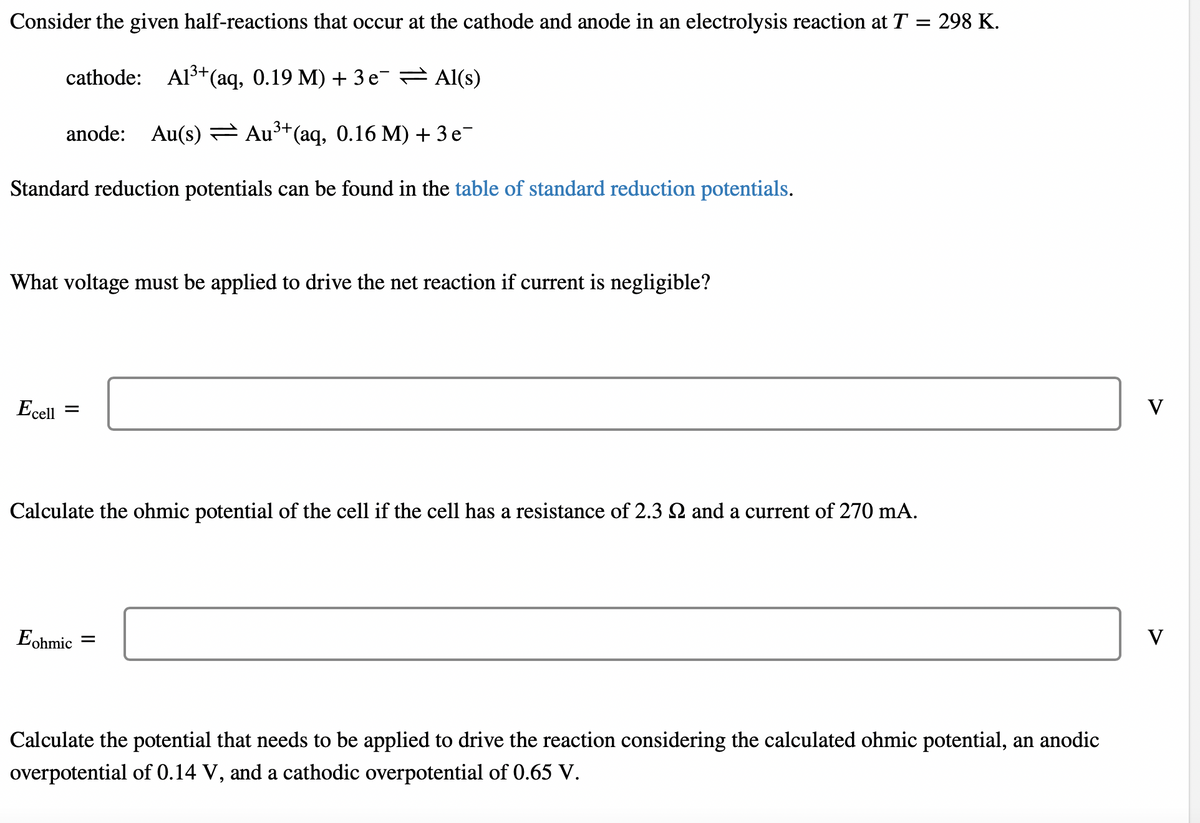Consider the given half-reactions that occur at the cathode and anode in an electrolysis reaction at T = 298 K. cathode: Al3+(aq, 0.19 M) + 3 e- 2 Al(s) anode: Au(s) Au3+(aq, 0.16 M) + 3 e- Standard reduction potentials can be found in the table of standard reduction potentials. What voltage must be applied to drive the net reaction if current is negligible? Ecell = V Calculate the ohmic potential of the cell if the cell has a resistance of 2.3 2 and a current of 270 mA. Eohmic = V Calculate the potential that needs to be applied to drive the reaction considering the calculated ohmic potential, an anodic overpotential of 0.14 V, and a cathodic overpotential of 0.65 V.
Consider the given half-reactions that occur at the cathode and anode in an electrolysis reaction at T = 298 K. cathode: Al3+(aq, 0.19 M) + 3 e- 2 Al(s) anode: Au(s) Au3+(aq, 0.16 M) + 3 e- Standard reduction potentials can be found in the table of standard reduction potentials. What voltage must be applied to drive the net reaction if current is negligible? Ecell = V Calculate the ohmic potential of the cell if the cell has a resistance of 2.3 2 and a current of 270 mA. Eohmic = V Calculate the potential that needs to be applied to drive the reaction considering the calculated ohmic potential, an anodic overpotential of 0.14 V, and a cathodic overpotential of 0.65 V.
Chemistry: Principles and Practice
3rd Edition
ISBN:9780534420123
Author:Daniel L. Reger, Scott R. Goode, David W. Ball, Edward Mercer
Publisher:Daniel L. Reger, Scott R. Goode, David W. Ball, Edward Mercer
Chapter18: Electrochemistry
Section: Chapter Questions
Problem 18.101QE: At 298 K, the solubility product constant for PbC2O4 is 8.5 1010, and the standard reduction...
Related questions
Question
![Calculate the potential that needs to be applied to drive the reaction considering the calculated ohmic potential, an anodic
overpotential of 0.14 V, and a cathodic overpotential of 0.65 V.
Eapplied =
V
If concentration polarization occurs in the cell and [Al³+], becomes 0.006 M and [Au³+], becomes 0.81 M, what potential must
be applied to drive the reaction? Assume the resistance, current, and overpotentials are the same as in the previous parts of
this question.
Eapplied =
V](/v2/_next/image?url=https%3A%2F%2Fcontent.bartleby.com%2Fqna-images%2Fquestion%2F81571cbb-3101-4e2d-9bdf-a797d25a4802%2F6d9ba088-1284-413b-8bcf-4d773349a29d%2F89c6xdf_processed.png&w=3840&q=75)
Transcribed Image Text:Calculate the potential that needs to be applied to drive the reaction considering the calculated ohmic potential, an anodic
overpotential of 0.14 V, and a cathodic overpotential of 0.65 V.
Eapplied =
V
If concentration polarization occurs in the cell and [Al³+], becomes 0.006 M and [Au³+], becomes 0.81 M, what potential must
be applied to drive the reaction? Assume the resistance, current, and overpotentials are the same as in the previous parts of
this question.
Eapplied =
V

Transcribed Image Text:Consider the given half-reactions that occur at the cathode and anode in an electrolysis reaction at T
298 K.
cathode: Al3+(aq, 0.19 M) + 3 e Al(s)
anode: Au(s) Au³*(aq, 0.16 M) + 3 e-
Standard reduction potentials can be found in the table of standard reduction potentials.
What voltage must be applied to drive the net reaction if current is negligible?
Ecell =
V
Calculate the ohmic potential of the cell if the cell has a resistance of 2.3 2 and a current of 270 mA.
Eohmic
V
Calculate the potential that needs to be applied to drive the reaction considering the calculated ohmic potential, an anodic
overpotential of 0.14 V, and a cathodic overpotential of 0.65 V.
Expert Solution
This question has been solved!
Explore an expertly crafted, step-by-step solution for a thorough understanding of key concepts.
This is a popular solution!
Trending now
This is a popular solution!
Step by step
Solved in 3 steps with 3 images

Knowledge Booster
Learn more about
Need a deep-dive on the concept behind this application? Look no further. Learn more about this topic, chemistry and related others by exploring similar questions and additional content below.Recommended textbooks for you

Chemistry: Principles and Practice
Chemistry
ISBN:
9780534420123
Author:
Daniel L. Reger, Scott R. Goode, David W. Ball, Edward Mercer
Publisher:
Cengage Learning

Chemistry & Chemical Reactivity
Chemistry
ISBN:
9781337399074
Author:
John C. Kotz, Paul M. Treichel, John Townsend, David Treichel
Publisher:
Cengage Learning

Chemistry & Chemical Reactivity
Chemistry
ISBN:
9781133949640
Author:
John C. Kotz, Paul M. Treichel, John Townsend, David Treichel
Publisher:
Cengage Learning

Chemistry: Principles and Practice
Chemistry
ISBN:
9780534420123
Author:
Daniel L. Reger, Scott R. Goode, David W. Ball, Edward Mercer
Publisher:
Cengage Learning

Chemistry & Chemical Reactivity
Chemistry
ISBN:
9781337399074
Author:
John C. Kotz, Paul M. Treichel, John Townsend, David Treichel
Publisher:
Cengage Learning

Chemistry & Chemical Reactivity
Chemistry
ISBN:
9781133949640
Author:
John C. Kotz, Paul M. Treichel, John Townsend, David Treichel
Publisher:
Cengage Learning

Principles of Modern Chemistry
Chemistry
ISBN:
9781305079113
Author:
David W. Oxtoby, H. Pat Gillis, Laurie J. Butler
Publisher:
Cengage Learning


Chemistry: An Atoms First Approach
Chemistry
ISBN:
9781305079243
Author:
Steven S. Zumdahl, Susan A. Zumdahl
Publisher:
Cengage Learning